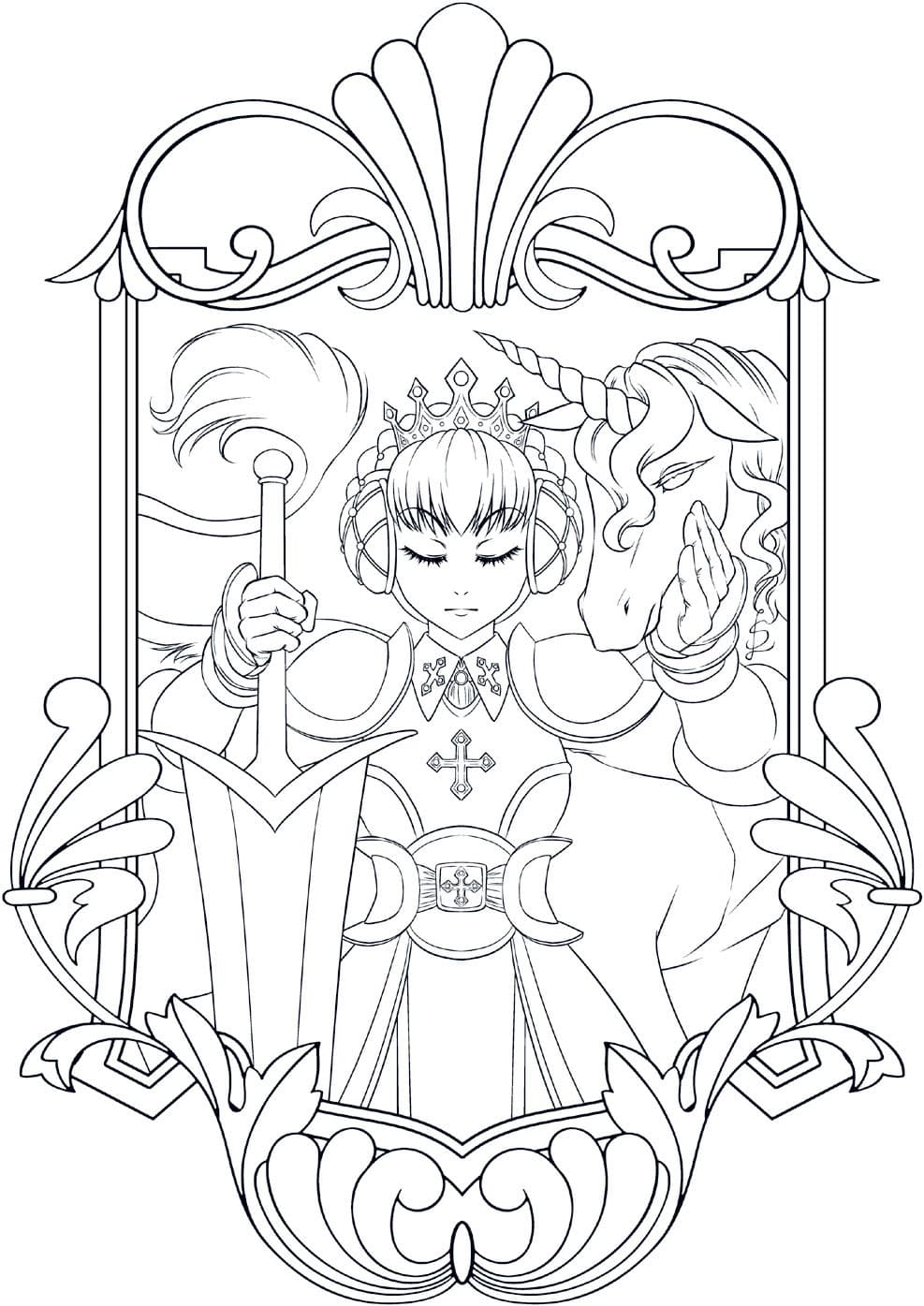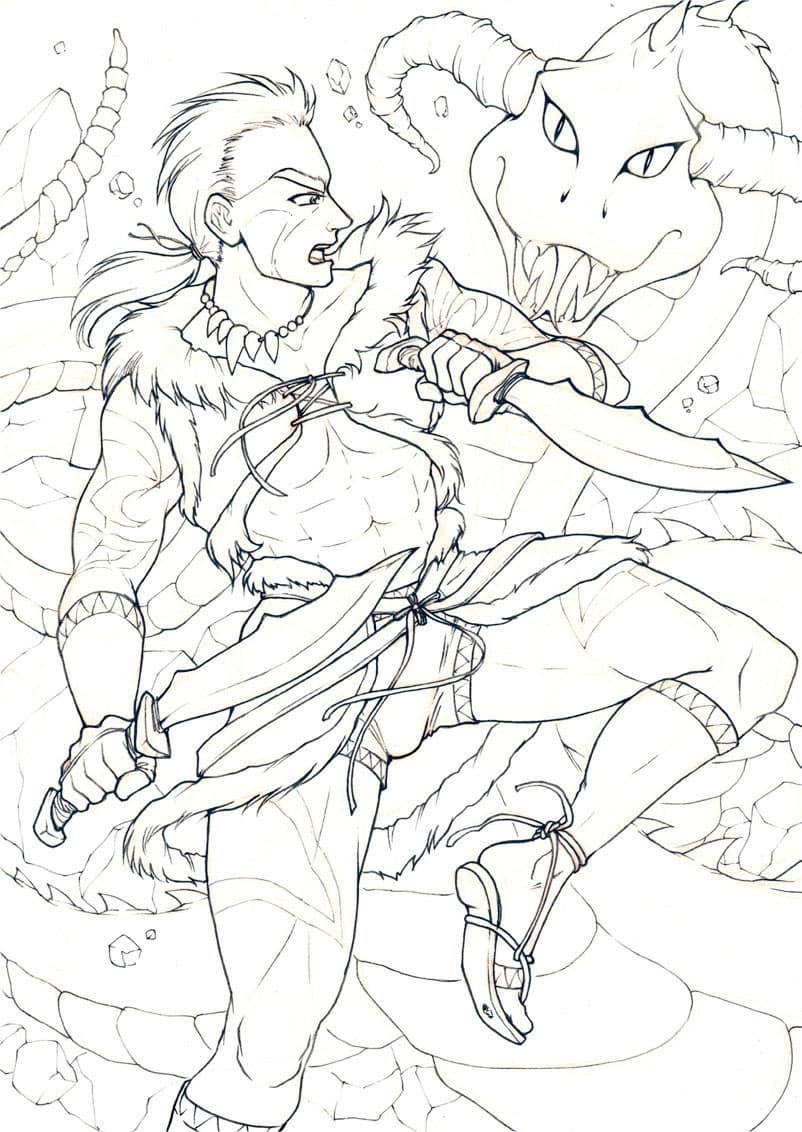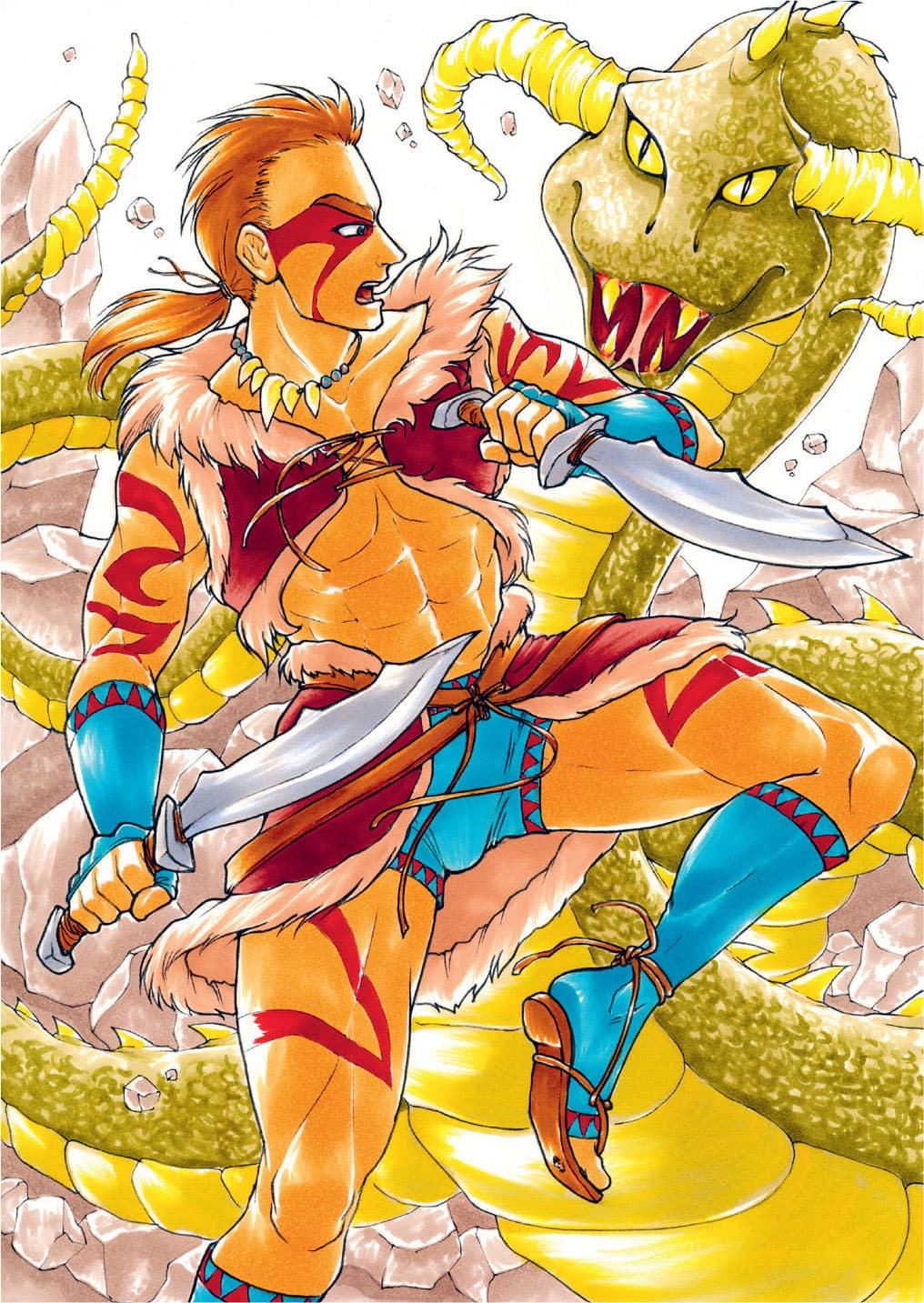FAIRY
BEAUTIFUL, FLUTTERY BEINGS OF FANTASY, FAIRIES ARE MAGICAL CREATURES WITH WINGS AND POINTED EARS. THEY COMMUNE WITH THE FOREST AND OFTEN HAVE MISCHIEVOUS, CHANGEABLE PERSONALITIES.

Faces: Often portrayed as wild children, fairies have youthful features with large eyes, arched brows, and pointed ears.

Insects: Look to butterflies, dragonflies, and beetles for inspiration. Use jewel tones in the wings, or make them transparent. Give fairies antennae or beetle horns.
Flora: Fairies commune with nature, so their clothing can range from basic and primal to opulent, always with natural accents. Accessorize your fairies with leaves, twigs, and flowers.
CHARACTER SHOWCASE: FAIRY QUEEN MAEVE
Elegant and exquisite, Fairy Queen Maeve’s delicate appearance belies her cunning nature. Commander of an army of fairies, she has powerful magic and casts illusions to trick her enemies. She grants wishes to the worthy and punishes those who deserve it.

STEP-BY-STEP: FAIRY QUEEN
COMPOSE A DRAWING THAT SHOWS OFF YOUR CHARACTER IN THE RIGHT SETTING. THINK CAREFULLY ABOUT THE FOREGROUND AND BACKGROUND ELEMENTS, AND ARRANGE THEM CORRECTLY.
I drew this fairy with mechanical pencils; then I scanned the image and colored it digitally.

Sketch the figure in red. Then neatly trace over your red lines using a black pencil. Scan the image and filter out the red, leaving only the black outlines.

On a layer beneath the lines, roughly paint a background; then insert a layer in between to lay down some flat colors in the figure.

For a painterly look, do all of the character’s shading and blending on a single layer, starting with the farthest elements (like the toadstool and the fairy’s hair) and gradually working your way forward.

DWARF
DWARVES HAVE A REPUTATION FOR BEING EARTHY, NO-NONSENSE, STURDY FOLK. SHORT IN STATURE BUT STRONG, THEY WORK HARD AND LOVE ALL THINGS THAT GLITTER.

Motifs: Take inspiration from old Norse and Celtic designs: animal furs and horns, jewelry that features knots and patterns, woven cloth, chunky metal rings and coins, and rough gemstones.
Build: Dwarves are shorter and stockier than most humans, so make sure to decrease their head-to-body ratio accordingly. Create square shapes with broad shoulders and hips to indicate their strength.
Hair: Dwarves are famous for having thick, bushy hair everywhere. Add beards, sideburns, mustaches, and long hair. Bring those locks under control by adding braids and wraps.

CHARACTER SHOWCASE: GOLDEMAR THE DWARVEN KING
Goldemar the Dwarven King is a mighty warrior, defending his homeland from invaders. His armor and hammer feature raw chunks of precious minerals. Although a fair and just king, he also likes to gamble, wagering gems on daredevil feats of bravery.

KNIGHT
THE MAIN CHARACTERS OF MOST MEDIEVAL FANTASIES, GALLANT KNIGHTS IN THEIR SHINING ARMOR ARE KNOWN FOR THEIR HEROISM AND SENSE OF DUTY, PROTECTING THE WEAK, SLAYING BEASTS, AND UPHOLDING HONOR.

Armor: Armor should not restrict movement. Segment large pieces around the joints of the body, protecting vulnerable areas, such as the heart, as well as protruding body parts like elbows.

Weapons: Knights are heavily armored in order to attack and defend in close combat. They will often use large swords, spears, and maces, and many carry shields.
Motifs: Knights can display heraldry or a coat of arms, which may go on a tabard they wear over their armor or on their shields.
CHARACTER SHOWCASE: PRINCESS ELEANOR
Princess Eleanor refuses to sit by and let others fight her battles. She insists on training with her father’s knights and has forged a reputation for herself as a skilled swordswoman.

STEP-BY-STEP: KNIGHT
VIEW TAPESTRIES AND OLD PAINTINGS FOR INSPIRATION WHEN DRAWING A KNIGHT.
I sketched and inked this image digitally; then I printed it and colored it in using markers and colored pencils.

Digitally sketch your main figure onto one layer and place the unicorn on another.

Neatly add ink over the sketch and design a frame around it, taking inspiration from ornate picture frames. Print a copy using a laser printer.

To add a calm, solemn mood to the image, incorporate soft lighting from above. Before working from light to dark, touch clear blender fluid to the colored tip of your marker to blend in gradient fills.

Let the ink dry; then add more layers of shadow and gradient fills to create depth in the image. Finish by adding sharp details and tints of color with colored pencil; use white paint for small highlights.

BATTLE MAGE
MAGIC CASTERS WHO WIELD SPELLS AGAINST THEIR FOES, MAGES THROW FIREBALLS, BOLTS OF LIGHTNING, AND WATER SPOUTS.

Robes: Mages rely on magic to attack and defend and don’t have to move quickly, so they tend to wear long robes or gowns with capes and hoods. They rarely carry weapons or wear heavy armor.

Accents: Mages may have magical symbols drawn on their clothing or equipment. Adorn them with patterns, sigils, talismans, gemstones, or jewelry.
Spells: Think carefully about the shapes their spells might take, such as fluid curves for water, sharp spikes for lightning, and so on.
CHARACTER SHOWCASE: SILAS THE ELF MAGE
Silas is a young but powerful elf mage who likes to research spells around the world and add them to his grimoire. A kindhearted being who often encounters trouble during his travels, he uses magic to protect himself and others from harm.

STEP-BY-STEP: BATTLE MAGE
DRAW YOUR MAGE IN A POSE THAT CLEARLY SHOWS HIS HAND WITH A SPELL FORMING AROUND IT. HERE HE PULLS IN THREADS OF MAGIC TO MAKE A ROSE BLOOM, SHOWING HIS SOFTER SIDE.
I sketched, inked, and added color digitally.

Sketch and then carefully add ink over your sketched lines. Use more than one layer for additional elements on top, like the rose and its petals. Then remove the sketch lines.

Add a layer beneath the lines and flat-fill in the midtone colors.

Add a layer beneath the lines and above the flat colors; then add sharp shadows, paying attention to the folds in the mage’s clothing.

WITCH
FEARED AND REVERED THROUGHOUT HISTORY, WITCHES ARE A POPULAR CHARACTER TYPE IN FANTASY, CONTEMPORARY, AND HORROR MANGA STORIES. USUALLY WOMEN WITH MYSTICAL POWERS, THEY CAN TAKE DIFFERENT FORMS, DEPENDING ON THE STORY.

Headwear: Often, a witch wears a cone-shaped hat with a wide brim or a cloak with a large, pointed hood.
Accessories: Brooms and cats are commonly associated with witches.
Clothing: Witches typically wear dark clothing, which can be primitive and loose, modest and prim, or cute and scholarly.
CHARACTER SHOWCASE: BRAMBLE THE WITCH
Bramble the witch loves to sit in her garden, sleep in the sun, and tend the herbs and flowers used in her potions. Plants are drawn to her, especially the briar rose, which never wants to leave her alone!

Bramble prefers to sit side-saddle on her broom!

WARRIOR
YOU CAN’T CREATE A FANTASY SERIES WITHOUT CHARACTERS WHO CAN HOLD THEIR OWN DURING A BATTLE! THERE ARE MANY TYPES OF WARRIORS AND JUST AS MANY WEAPONS TO GO WITH THEIR VARIOUS STYLES OF ATTACK.

Clothing: Most warriors wear less armor than knights (shown here), and they may show off lighter pieces as well, like leather jerkins or partial breastplates. Their clothing must match their fighting style.

Specialties: Think of a specific occupation for the warrior you’re drawing and try to tailor your character design for the job. Here are a few ideas to get you started: assassin, ranger, berserker, mercenary, rogue, or soldier.
Weapons: Warriors may carry swords, axes, daggers, pole weapons, bows, crossbows, muskets, or slings. They need somewhere to store their ammunition—so don’t forget their arrows or bandoliers!
CHARACTER SHOWCASE: KHAIDU
Young warrior Khaidu has something to prove. Wishing to earn a reputation within his tribe as a champion, he seeks to slay the most fearsome monsters in the land and bring back trophies as proof of his bravery and skill.

STEP-BY-STEP: WARRIOR
DRAW KHAIDU AS HE CONFRONTS A GIANT HORNED SERPENT ON A MOUNTAINTOP. FEATURE PLENTY OF ACTION IN YOUR IMAGE!
I sketched with colored pencils, inked with fineliner pens, and added color with markers.

Sketch Khaidu the warrior just as the serpent is poised to strike. Use the serpent’s coils to fill the space. With a fairly thick fineliner pen, ink the warrior (he’s in the foreground; thicker lines convey this position). Switch to a thinner pen for the serpent and the rocks.

For strong, sun-bleached lighting, use light- and medium-toned markers to color in the background elements.

Having established the lighting, begin adding colors and shading to the warrior, leaving the outer edges white to create a backlit effect.

ANGEL
IN A TYPICAL MANGA STORY, ANGELS ARE DRAWN AS BEAUTIFUL, PURE BEINGS SYMBOLIZING GOODNESS AND LIGHT. THEY OFTEN SERVE AS GUARDIANS OR PROTECTORS, FLYING IN TO RESCUE THOSE IN NEED, FIGHT OFF EVIL, AND DISPEL DARKNESS.

Halo: To imply a feeling of radiance, angels are sometimes shown with a shining halo on the head or even a glow around the whole body. Create interesting shapes for your angels.
Robes: In classical paintings, angels are often dressed in flowing, fluttering robes and sashes.
Wings: Imagine the snowy white wings of a dove and how they create a feeling of purity and peace. Look at birds’ feathers for help with drawing an angel’s wings.
CHARACTER SHOWCASE: SERAPHIEL
Seraphiel is a high-ranking archangel with six wings as opposed to the usual two. Archangels are the most powerful angels, leading and assigning tasks to other angels around the world, as well as taking on the most difficult challenges in the fight against evil.

STEP-BY-STEP: ANGEL
TAKE INSPIRATION FROM CLASSICAL PAINTINGS AS YOU SKETCH AND COLOR THIS ANGEL.

Sketch Seraphiel in a praying position: looking up toward the light, with wings folded slightly. Use a medium close-up depiction to accurately represent the facial expression.
I sketched my character in pencil; then I scanned the image and painted it digitally.

To create the look of a traditional oil painting, do all of your coloring on one layer. Keep the lines on one layer as guidelines; then on the color layer, fill in with dark brown and add your color palette from light to dark.

Pipette from the middle tones of your palette and roughly fill in some base colors directly onto the dark brown of the color layer. Use a mixture of highlight and shadow tones.

Continue to pipette from your palette and paint highlights and shadows across the whole piece. Toggle the line art layer on and off to check for sufficient definition in the paintwork. Then, working from the back, add fine details with distinct brushstrokes, and increase the contrast.

